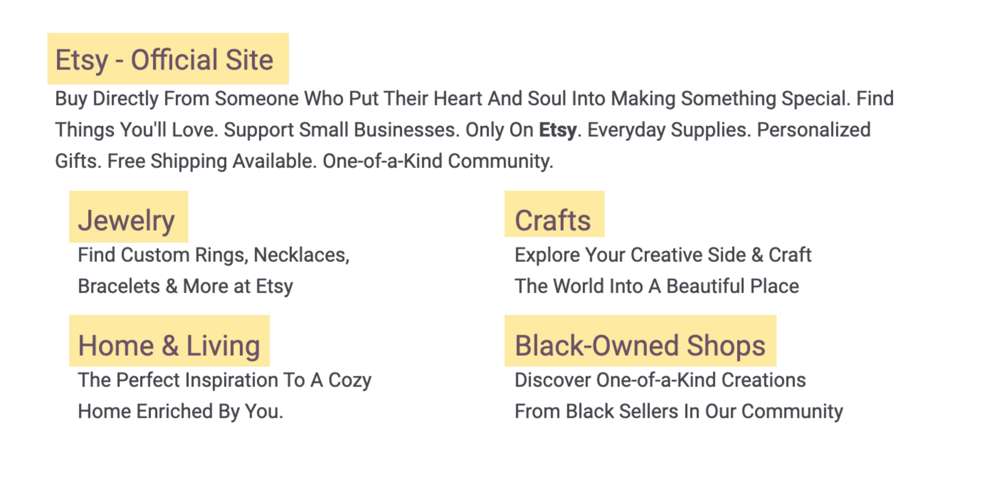Summer Success Series: Improve Your SEO in 30 minutes

Step 1: Two Free Tools for Better SEO
What is SEO?
Search Engine Optimization (SEO) is the practice of improving your website’s content with the goal of gaining a better position on search engines, like Google. This isn’t about paying for a Google Ad to show up at the top of the page. It’s using content to show Google (over time) that your business is a real authority on your subject. It’s basically a free way to gain targeted traffic to your website.
Say you own a veterinary office. What’s the best way for someone to find you? Likely, it would be by searching on the internet, which means a Google search. If they’re in, say, Hendersonville, they’ll probably search “veterinarian in Hendersonville, NC.” With SEO, you can (to a certain extent) control the position of your small business in the search results when a potential customer searches for those keywords.
It’s really important to note that small things like adding relevant keywords to your website will help improve your positioning, but there’s a bit more to it. This week, we’re going to focus on implementing a few tools and some assessments of your site you can conduct that will make a material difference on your sites position in search almost right away. Don’t worry, I’m going to walk you through everything!
First up, Google Trends.
- Google Trends is a free-for-anyone tool that you can start using now to get a better idea of what your local community is searching the internet for. Better yet, you can drill down to specific keywords you think people might search for.
- Say you run a mobile photography business. With Google Trends, you can pinpoint how many people are searching online for the term “family photographer” in any state, and you can see that data by year, month, or even week. You’ll find this term to be more popular in the summer months in northern states, which means you might want to hang out in those areas during your summertime travels.

Next up, Google Search Console.
- Google Search Console is another free tool, but this one actively tracks data for your website. It can show you how many times your brand has been viewed on search engines (a.k.a. impressions) and what kinds of keywords people are searching before seeing or clicking on your website, among other things (which I talk about in the video below).
NOTE: You can start understanding your potential audience by watching your impression numbers with Google Search Console and comparing that to your traffic numbers in Google Analytics. Out of all the people in Google Search Console who SAW your brand, how many actually made it to your website during the same time frame? What keywords did they use? Should you have shown up in their results or not? There may be some keywords that you DON’T want to show up for.
Google Search Console will tell you so much about your audience, and will give you a few insights into changes you can make to improve conversions, like focusing on the right keywords in your content, fixing errors on your web pages, and getting new keyword ideas.
- If you want to learn a little more about utilizing Google Search Console, here’s a handy video.

NOTE: We’ll come back to this video later in the Summer Success Series. Once you verify your website with Google Search Console, it can take days or weeks to see data. Implementation is this week, and analyzing that data will come later.
Between now and Wednesday, I’d love for you to follow through with these key action items:
- Spend 10 minutes brainstorming keywords that your audience might be searching for.
- Add those words to Google Trends.
- What kind of data do you see?
- This tool is free! Don’t be afraid to experiment.
NOTE: The more terms you can think of, the better. You might be surprised to find that some phrases are better than you thought, or some no-brainers are actually lacking in traffic in your area. We’ve certainly been surprised to find that the term “startup” is less popular than the term “small business” when it comes to the way entrepreneurs search in Western North Carolina.
2. Take that list and organize it from most-traffic to least. The keywords with the most traffic are going to bring you a wider audience with the right intentions. They want what you have!
- Take the first 5-10 phrases and start incorporating that into your website’s content in a way that makes sense to you.
NOTE: The more those key phrases appear (without looking phishy), the more Google will be like, “Oh, hey, they know what they’re talking about!” and you will rise in rankings. Remember: SEO is a slow game. It will take a few weeks to start seeing results depending on how aggressive you are with this strategy.
3. Spend another 10 minutes implementing Google Search Console on your website. You’ll either need Google Tag Manager, Google Analytics, or access to your DNS provider account. Google makes it very easy, and provides easy-to-follow instructions every step of the way. Click here to get started.
NOTE: Once Google Search Console is added to your site, it will start collecting data. Check back in a few days to see how your site is performing. The sooner you add this to your website, the sooner you’ll be collecting data on your site for FREE.
If you’re interested in learning more about Google Search Console now (and have about an hour on your hands), I highly recommend this video. This is not required, but is very informative. It will also help you when we come back to Google Search Console later in the Summer Success Series.
Step 2: Create Quality Meta Descriptions for More Website Traffic
What’s a meta description?
The meta description is the little snippet of information search engines like Google show to people in the search results for your website. It will look like this:

The blue titles are headlines, or H1s (which we’ll dive into next time). These headlines tell Google what searches your website should show up for, and potential customers what you’re all about.
The meta description is the lighter content under the H1 (I’ve highlighted it for your viewing convenience). This content helps improve your SEO ranking (your position in Google) if it’s done right. It tells potential customers exactly what you’re up to. Make sure this content is compelling and sincere. You want people to know what you offer, and you want them to WANT to click over to your website to make a purchase.
Why does the meta description matter?
When searching on Google for a service, you aren’t just going to click the first link. Because, let’s be real, it’s likely a paid ad spot. You want an organic search result that tells you what you want to hear (or buy). Why do you want an organic search result? Because that means Google’s mystical, all-knowing algorithm has dubbed that website worthy for a number of reasons. It also means that website has likely been around longer and has worked harder to get there. It’s just more trustworthy.
For example, as I was looking at the search results for the term “Vegetable Chopper,” I noticed these vastly different meta descriptions. Which one do you think shows higher in Google search results?

Hint: Google bolds the keywords you search for in the meta description to make it easier to find the most relevant website. One description has no keywords while the other has three.
How do I do this?
- Search for your website on Google. What do the search results look like? This will give you an idea of how your potential audience is seeing you in Google search results.
- You can also use Google Search Console to see your search results and improvements.
- Note that the meta descriptions showing in Google could just be the Google gods placing them there. If a meta description is left blank, Google will replace it with copy from the website, no matter how relevant it is.
- Download the freeYoast SEO plug-in to your WordPress site (if you don’t use WP, there is likely a similar plug-in!). This plug-in allows you to create your own meta tags, titles, and descriptions on your website so the power to get better organic traffic is in your hands, not Google’s algorithm. Get started:
- Log into your WordPress site and click “plug-ins” on the left hand menu, and then “add new.”
- Search for “Yoast SEO” and download it.
- Then, use the Yoast plug-in to change your homepage meta description. Take power into your own hands and write a meta description that makes sense for your brand. This means, even if you liked the way it looked on Google when you searched for your website, it can likely be improved.
- Make sure it also makes sense for the page itself. Don’t just describe your brand like the Family Dollar example above, but instead, describe the benefits and value of your product. That’s what people will search for.
- Spend a few minutes reviewing your website and find the top 3-5 pages that are either the most visited pages or pages that you consider a priority (think top navigation on your site).
- You can find your highest volume pages in Google Analytics, or by digging around in Google Search Console.
- Update the meta descriptions for those top 3-5 pages in addition to the work you did for your homepage.
Now, sit back and watch your organic traffic grow over the next several weeks.
Step 3: Making Your Headlines SEO Friendly
What are H1s?
Headlines, or H1s, appear in a variety of places, like on your website and in Google Search results. Here are the primary ways you’re going to use them on your website:
Page Titles – This is the title of a particular webpage (highlighted in yellow). This shows at the top of the page and tells your customers what the content will be about. Titles can be changed through the backend of your website.

Content Titles – Similarly, your blogs posts likely have an H1.

Meta Headlines – You know those blue headlines in Google search? Those are H1s showing up in Google.

Why do these matter?
Your H1s tell everyone who isn’t familiar with your website what it is they will find on that page. These are extremely important for getting the right people to your website. The right people are those who are more likely to convert and make a purchase.
How do I make my H1s better?
Your H1s should be relevant, clear, and compelling. When you’re crafting them, think about how your audience uses a search engine. What are they really searching for in Google before they land on your website? Use Google Trends and Google Search Console (once your data starts filtering in) to make your decisions about what keywords and phrases to use in your H1s.
Other than finding the right keywords to target, there are a few mistakes companies make that hurt their SEO in the name of organization and voice.
- Organizational headlines should reflect the content. Not only will bolding the most important thing on the page and making it large help your audience get to the content they are looking for faster (have you scrolled through the 1,452 miles that is a recipe blog post?), but it will tell Google to look more closely at a key phrase, shifting you up on the search list.
- For example, Company A uses, “Where Are We?” as a headline on their Contact Us page and Company B uses, “Serving West Texas” as their headline. Who do you think Google trusts more? By adding the location to this headline, Company B will capture more people who are searching for things in West Texas specifically.
- Don’t completely lose your personality and brand voice. Think about how people search for things on Google. If I’m looking for a Chinese restaurant near me, I’m not going to type in, “You’ll Love the Dumplings,” but I will search for, “Chinese Dumplings Buffalo, NY.” You can do this strategically. Make your headlines relevant and searchable, but don’t skimp on the personality where there is room for it, like, “The Best Chinese Dumplings in Buffalo.”
- Think about the benefit and value of your product. Yes, ask yourself what people are searching for, but also ask yourself, what are they truly trying to get out of your brand? What pain point are they trying to avoid?
- For example, you might use, “Protect Your Intellectual Property” for a headline as opposed to, “IP Lawyers Standing By.”
Go forth, my grasshopper. Here are a few action items.
- Brainstorm keywords and phrases you want to show up for in Google.
- Craft headlines for your top pages and blogs using those key phrases
- Add those shiny new headlines to your website!
It’s that simple to create traction with your Google search position.
How long will it take to see results?
Great question! It’s going to take a couple weeks for your organic traffic to start growing based on traffic and current website users’ response. Don’t forget to add Google Search Console to your website now so you can analyze with this tool.
Like what you read? Sign up to receive more content like this here!
Share this Article!
Want to write an article for our website? Learn more and submit a guest blog here.


